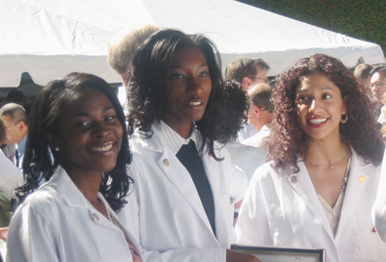MED welcomes its most academically qualified and diverse class

The School of Medicine’s incoming class boasts several distinctions this year — academically, it is the most highly qualified in MED history and in some respects the most diverse.
Admissions staff reviewed 10,000 applications for the 114 available seats in this year’s entering class, says Robert Witzburg, associate dean and director of admissions at MED. That’s the highest ratio of applicants to available seats of all 125 U.S. medical schools, he says.
“The academic strength of the class is as strong or stronger than it has ever been,” says Witzburg, who is also a MED professor of medicine and an SPH professor of health services.
This academic year also marks the fourth consecutive MED entering class with more women than men — 59 percent of first-year medical students are female. Prior to 2002, the school had not admitted more women than men since 1888.
The School of Medicine was founded in 1848 as the New England Female Medical College. The first medical school in the United States for women, it taught women exclusively until 1873, when it became the Boston University School of Medicine. At that point, the school began to admit men, becoming the first coed medical school in the country. Male students outnumbered female students from 1889 to 2001.
Many factors are driving the increased number of women studying medicine at BU, Witzburg says. One is that historically, men had fared better on the MCAT medical school entrance exam than women; in recent years, that gap has disappeared, he says.
The trend is apparent across the entire Medical Campus. At the Goldman School of Dental Medicine, women make up nearly half of the 115 new students, and 80 percent of the incoming class at SPH is female. “I think the trend at BU parallels the trend nationally, at undergraduate and professional schools,” Witzburg says.
Minority students also continue to grow in number at School of Medicine. Last year’s entering class included more underepresented minorities (African-Americans, Hispanics and Native Americans) than any other medical school in Massachusetts, according to a report from the Association of American Medical Colleges (AAMC).
The 15 black students who enrolled at MED last year account for 9.7 percent of the class. Harvard Medical School admitted 13 black students last year, Tufts, 7, and UMass Medical School, 3, according to the report.
“We are well above the national average for minority matriculation,” says Kenneth Edelin, MED associate dean for students and minority affairs. Statistics on how MED’s incoming class compares to that of other schools numbers of minorities have yet to be released by AAMC.
Of last year’s 15 black students, Edelin says, 11 entered through the Early Medical School Selection Program (EMSSP). The EMSSP program works with students from a network of 10 historically black colleges and universities. Participants come to BU for summer sessions and senior year. If they meet the admission standards, they are “promoted” to the medical school upon graduating.
Witzburg says that of this year’s entering class, 10 of the 28 underepresented minority students arrived via the EMSSP program.